QuestionMy 3 yr old pbp is mostly white and got sunburn pretty bad sometime in April. We are in SE Georgia. I didn't actually realize it until her skin began to peel. She is such a baby when it comes to any treatment and would barely let me spray her and then began to run at the sight of me til I gave up. I don't know if the two are related but for weeks now she doesn't get out and about except to eat her feed which I cut back on because w/no excercise she can't afford to gain any weight. I'm embarrassed to say she is probably close to 200lb. Is there anything to boost her energy? I also need to know what to do about her hooves. She will not let me trim them. Is there a hoof softner that would allow them to file themselves down? Sorry to go on and on, but I have no near by vet that has a clue. Judy
AnswerIt sounds like there's several parts to this problem. Sunburn, weight, hooves and lack of exercise. Usually, overweight pigs with bad hoofs often have some form of arthritis or back pain, too.
Weight is misleading when it comes to pot-bellied pigs. A small pig will weigh more than a small dog the same size. Also, larger pot-bellied pigs can be surprisingly heavy, even when they are at a weight ideal for their body size. So when it comes to weight, most pig lovers don't worry about the number so much as how the pig looks and acts. Are the eyes visible? Can they get up and move around easily? Are ribs showing? Or does the pig look like he's swallowed a basketball?
That said, you will need to know the approximate weight of your pig to use the following remedies. There's a step-by-step method of finding the pigs weight by measuring their body here http://www.pigpalssanctuary.com/health/size_weight.htm
"Hungry" pigs are active pigs. They snurdle around looking for tiny bits of anything interesting and potentially edible. "Full" pigs nap. So the first step to getting your pig active and back on track to a good weight is reducing the food, which you have already done.
The general rule of thumb for adult pigs is 1 cup food per 75 lb of body weight (adjusted for the pigs frame, activity level, etc). Since you're trying to get some weight off your pig, I would offer slightly less than the recommended amount plus fresh veggies, split into 2 meals. You can also split each meal in half, giving her the veggies in one place, then make her walk to another to get the pellets.
The Oat Diet works well for pigs that need to loose a drastic amount of weight. Substitute plain oats for a portion of the pellets. One popular plan is to start with 1/2 oats, 1/2 pellets for two or maybe three months (not too long - oats don't have the same nutrition as pellets!), then for breakfast all pellets, for dinner, 1/2 pellets, 1/2 oats, plus veggies until the pig is back to normal weight.
Another way to get her active is to split off 1/4 cup of the pellets, and scatter them around about an hour before the usual dinner time. She'll be hungry then, and more willing to get up and snurdle around for the pellets.
Hooves can be a big problem. Long hooves push the leg back into an awkward position, over time, this can lead to joint deformity and arthritis. Imagine if you had to wear an ill-fitting pair of high heeled shoes 24-7! So, as difficult as it may seem, it's important to get those feet down to size.
I've found that cutting wire (available at www.jefferslivestock.com) works really well to get through the thick stuff quickly without cracking or splitting the hoof, but watch because the friction makes the wire get hot fast. If you smell an odd odor, the wire is hot and you'll need to pause for a moment to let it cool. Smaller hooves can be trimmed with goat hoof trimmers (available from www.pigstuff.com or www.pigs4ever.com). A sharp wood rasp can be used like an emery board to smooth and shape the trimmed hoof. Cordless dremels work too, but the sound and vibration may disturb the pig (who will probably already be upset about the trimming!)
To trim the hooves, you'll need a couple of strong, brave people and you might want to offer them earplugs. Get the pig into a small area well padded with lots of straw (at least 2 ft deep). Roll the pig onto her side or back, have one person hold the pig in position, another hold the leg and foot, and the third person trims. One of my pigs always poops when we do this so wear old clothes!
Now for the sunburn. I am assuming that it is simple sunburn and not erysipelas. Some of the symptoms of erysipelas include lethargy, loss of appetite, raised square-ish or diamond-ish shaped lesions which peel deeply. I am not a vet and can not make any sort of medical diagnosis over the internet, but I think it's safe to say that if this situation has been going on for weeks, it's probably not erysipelas. Snake bites can also cause fever and deep peeling, but if you saw no bite marks that's probably not the cause.
You can use any human sunburn remedy on your pig. Pigs do hate to be squirted or sprayed, especially with a cold spray or lotion. So use a lotion, and put the container into a bowl of really hot water for a few minutes. Rub your hands to get warm, put a little warm lotion on your hands, then rub it on the pig.
Finally, she may be immobile due to a strain or injury. This happens a lot with overweight pigs who have been inactive all winter, then go out and overdo the exercise on the first nice day of spring. Rimadyl is an ideal pain-reliever for pot-bellied pigs, but can be hard on the stomach, Deramaxx and Previcox less so. The vets in your area may be unfamiliar with pot-bellied pigs, but perhaps one might be willing to see yours in order to write a prescription for a NSAID (non-steriodal anti-inflamatory drug). Aspirin works too, but it's really a last resort because the side effects (blood thinning and stomach ulcers) can cause trouble. The rule is 325 mg per 75 lb of pig. ALWAYS use buffered aspirins. ALWAYS give aspirin or a NSAID to the pig on a full stomach only. Also, many vets recommend using Pepcid AC or a similar product on the pig as long as the pig is taking painkillers.
Finally take a good look around at her shelter, the doorway, etc. Look for anything new or different that might have disturbed her. Pigs, especially ones who have trouble seeing, are easily disturbed by changes in their surroundings. Make sure it's easy for her to get in and out, that she doesn't have to step over a high threshold, doesn't sink in deep mud just outside the door, etc.

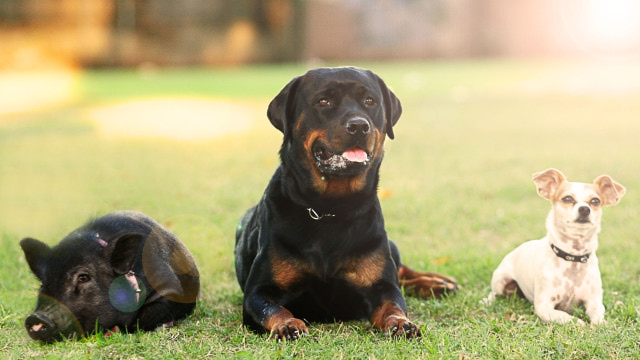 Pot belly pig nose rubbing
Question
Recent pic of our kids Alize
Hel
Pot belly pig nose rubbing
Question
Recent pic of our kids Alize
Hel
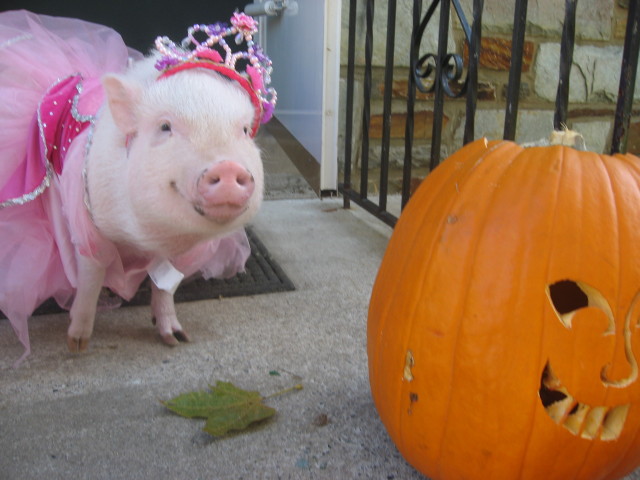 Grinding teeth/licking
Question
Madelyns 1st Hallowee
Hello,
I have a 3yr ol
Grinding teeth/licking
Question
Madelyns 1st Hallowee
Hello,
I have a 3yr ol
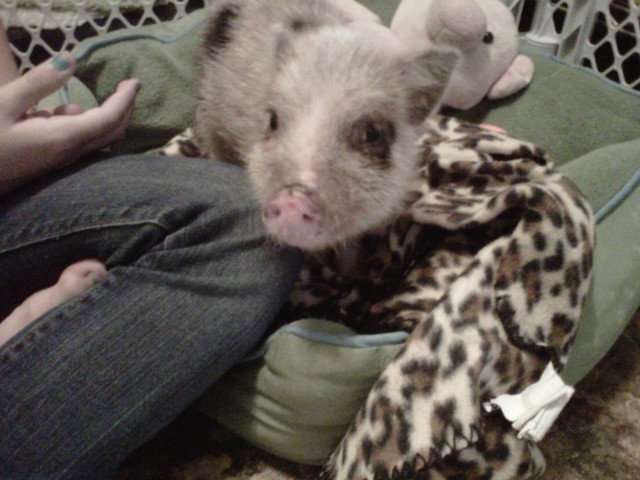 PBP and hiccups
Question
Hi!! Im new to the forum, I hope Im as
PBP and hiccups
Question
Hi!! Im new to the forum, I hope Im as
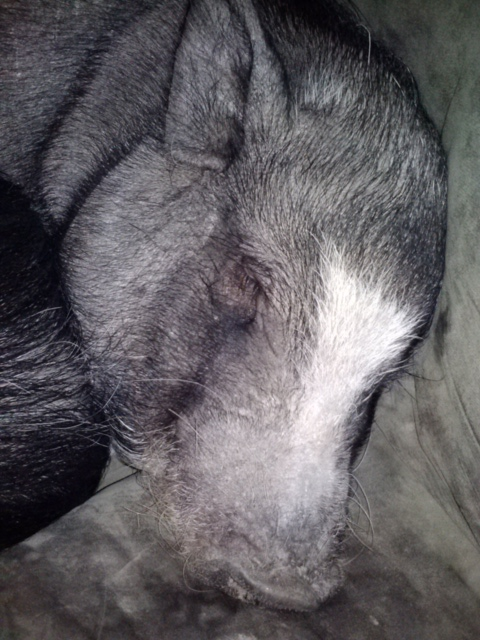 my micro mini pot belly piggy Babygirl..
Question
Babygirls face
Babygirl went through a
my micro mini pot belly piggy Babygirl..
Question
Babygirls face
Babygirl went through a
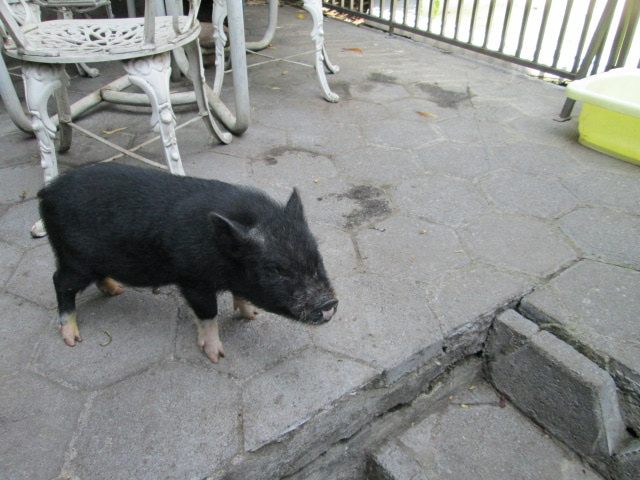 Diet
Question
Nicanor
Hi, Nicanor is 7 months old and
Diet
Question
Nicanor
Hi, Nicanor is 7 months old and